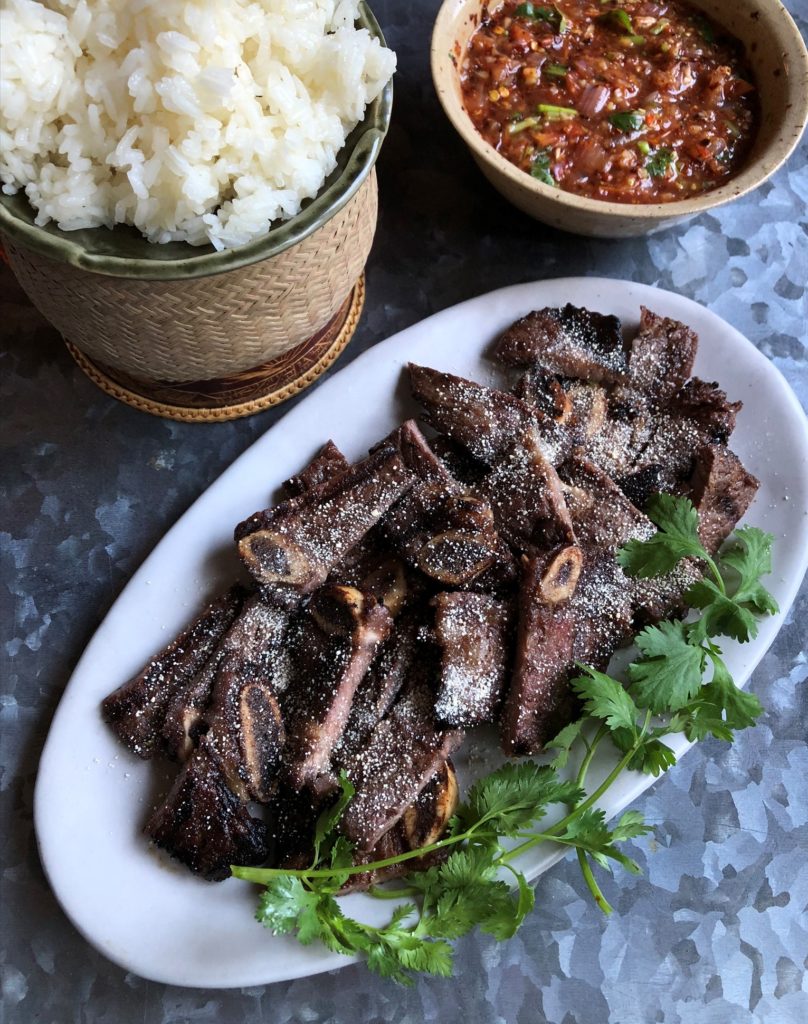
Do you read weekly supermarket circulars? I do and learned to from my mom, who reads them like the Bible, she says. Nowadays, I scan what lands in my inbox, as well as my snail mailbox. My husband does too (another reason why I married well!). This week, there was a Whole Foods sale on flanken-style beef short ribs. The friendly butcher, Alejandro, had cut beautifully thin pieces of the thin fatty beef. He knew that I like super marbly meat and happily chose half a dozen pieces.
We don't eat much meat these days, so whatever I did with them had to be extra satisfying. Flanken-style beef short ribs are typically used for Korean barbecue, but we'd recently gone through a Korean phase with the tteokbokki spicy rice cakes that I posted. Not wanting to shop at an Asian market for anything super special, I began perusing my grilling cookbook collection.
In Leela Punyaratabandhu's latest publication, Flavors of the Southeast Asian Grill, I found a great recipe for Thai suea ronghai, crying tiger grilled beef with a spicy roasted tomato sauce. The ingredients were all on hand or readily available - oyster sauce, soy sauce, white pepper was as crazy as it would get.
Crying tiger is something I've ordered at Thai restaurants but frankly wasn't overly impressed with. The beef is usually lackluster, served with a so-so spicy sauce.
Not until reading Leela's recipe did I know that crying tiger involved garnishing the grilled beef with nutty ground toasted rice (called khao khua in Thai, thính in Vietnamese). Sadly, Thai restaurants often omit it, just like they often do with larb. Maybe making crying tiger at home would be enlightening? I was willing to see.
Beef choices
Leela points out in the recipe headnote that in Thailand, a wide range of beef cuts is grilled. She gravitated toward skirt steak after she came to America and discovered its beef flavor and appealing chew. She mentioned that the meat buckles during grilling so you have to press it down with a burger press. I didn't have a metal burger press, but I didn't need it. The fatty flanken short ribs offer good chew and richness. There's no need to press it since the pieces are short and don't buckle and bend during cooking.
If you select the short ribs, make sure they're thinly cut like for Korean barbecue. You don't want the thick chunks of single bone pieces often labeled short ribs or English-cut short ribs. Those are great for braises and other long-cooking projects. Flanken-style short ribs take about six minutes on a hot grill to achieve perfection. They satisfy due to their fattiness so I tend to eat less of it. With six pieces weighing roughly 1 ⅔ pounds, there was enough for 4 moderate eaters.

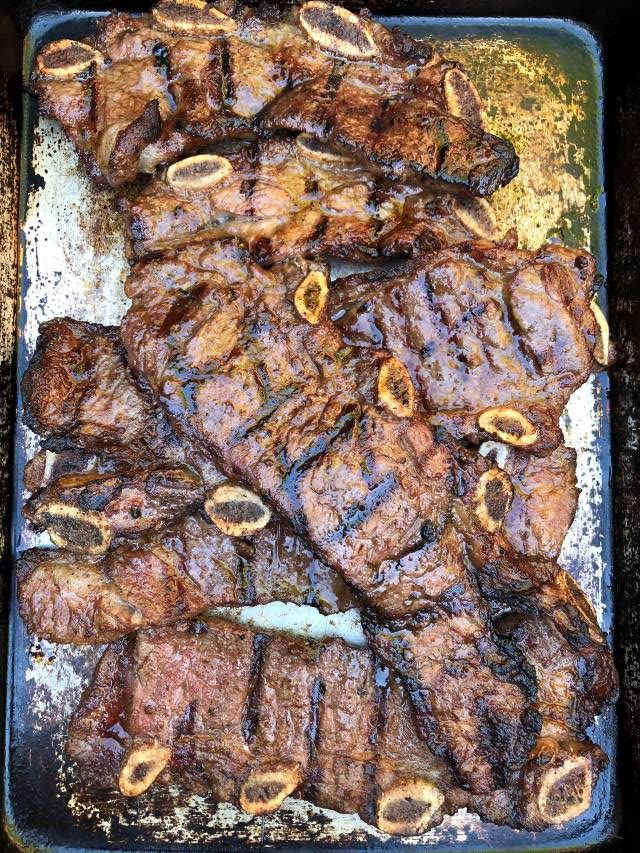
Aside from skirt and flanken-style short ribs, you could also try flap steak. It's inexpensive and may be called sirloin tips in New England. Flap steak is great for carne asada too! So is skirt steak, and I imagine the flanken short ribs as well. Now you may get the picture of what you may select to grill: something flavorful and good that you can grill fast, that you may use for carne asada would definitely be good for crying tiger.
Marinade and Skewer Cleverness
The original recipe called for 3 pounds of skirt steak. Since I employed roughly half that amount, I halved the marinade. It didn't seem like enough but turns out, it was JUST perfect to coat the short ribs without being overly saucy. That means you can just slap it onto the hot grill grates without blotting off excess moisture beforehand!
Grilling the sauce ingredients is easy with skewers. I used fat skewers purchased from a Middle East market because that's where kebab masters shop: for fast grilling action over moderate or moderate-hot heat, fat skewers such as these do not need soaking in water. You can soak them for good measure but since I switched to them, I've not had a skewer burn out.

My problem was really with keeping the tomatoes and garlic on the skewer. Selecting larger cherry tomatoes and grilling them whole solved the problem; bigger garlic helped too, even though some of mine split during threading. No biggie. Just monitor the grilling and pull off ones that slide from the skewer or fall onto the grates.
The gas grill worked fine with half of it heated to moderate and the other half to hot. I grilled the sauce ingredients on one side and the beef on the other. Charcoal would be more true to what's used in Southeast Asia, as Leela writes in her book.
Toasted Rice Powder
How can 1 tablespoon of rice make a difference? Toasting the grains of raw rice adds interesting texture and nutty flavor. In the main, Thai cooks use sticky rice, sometimes soaking it as is called for by Pok Pok here, and sometimes not. Viet cooks tend to use regular long grain rice. It takes time but makes a difference in dishes. The rice is used as a garnish, in salads, sauces, and mixtures like Viet bì heo, finely shredded skin with poached pork.
You can use an electric coffee grinder to rend the toasted rice into a powder. In this video I went unplugged because there's only 1 tablespoon of rice involved.
What makes the Tiger Cry?
The spicy sauce is key, but don't be scared. I kept Leela's recipe at a full batch even though I had only half the meat. I love sauces, and this one doesn't disappoint. It's wonderfully layered with flavors. The roasted ingredients, fish sauce, sauce, lime juice and touch of sugar mollify the red pepper.

I've included a range in my adaptation below, in case you're concerned. But know that as the sauce sits, the pepper flakes hydrate and swell to thicken the sauce. You can always add more pepper flakes. I went with a good 2 tablespoons but think I could tolerate the full 3 tablespoons that Leela called for in her marvelous book. (Yes, I'm waiting for countertops in our kitchen redo!)
Below is the recipe for you to tinker with. Go at it!
Crying Tiger Grilled Beef with Spicy Roasted Tomato Sauce
Ingredients
- 2 tablespoons neutral oil
- 1 tablespoon soy sauce
- 1 tablespoon oyster sauce
- 1 teaspoon ground white or black pepper
- 6 flanken-style beef short ribs, about 1 ⅔ pounds total
- 1 tablespoon raw glutinous or long-grain rice
- 6 ounces cherry tomatoes
- 1 ½ ounces shallot, halved
- 5 large garlic cloves
- 1 tablespoon fish sauce
- 2 tablespoons fresh lime juice
- 1 ½ to 3 tablespoons red pepper flakes
- 1 teaspoon packed light brown sugar or palm sugar
- ¼ cup coarsely chopped cilantro leaves and stems
- Handful cilantro sprigs, coarsely chopped, for garnish
- Cooked sticky or regular rice, for serving
Instructions
- For the beef, in a wide bowl or square pan, stir together the oil, soy sauce, oyster sauce, and pepper. Add the beef and turn to coat all sides. There should be little lingering marinade.
- If needed, soak 4 or 5 12-inch bamboo skewers in water to cover for 1 to 2 hours.
- Meanwhile, put the rice in a small dry skillet and toast over medium-low heat, stirring almost constantly, until the grains are golden brown and have a nutty aroma, about 15 minutes. Transfer the rice to a small heatproof bowl and let cool completely (do not leave it in the pan as it will continue to toast). In a small food processor or a mortar, grind the rise to a coarse powder, then set aside.
- Prepare a medium-high fire in a charcoal grill or preheat a gas grill to medium on one half and medium-hot on the other half.
- To make the sauce: Thread the tomatoes, shallot halves, and garlic onto the soak skewers, keeping each ingredient on its own skewer or skewers. When the grill is ready, place the skewers on the grill in an area with moderate heat. Cook uncovered, turning frequently, until charred and soften, 5 to 10 minutes. Transfer to a plate and cool while you cook the beef.
- While the skewers are cooling, place the beef on the grill on the hot side and cook uncovered, turning once, until cooked, 2 to 3 minutes per side and nicely browned and juicy. Transfer to a cutting board and let rest for 10 to 15 minutes.
- While the beef rests, put the grilled tomato shallots and garlic into a food processor and pulse to a coarse texture. Transfer to a serving bowl and stir in the fish sauce, lime juice, 1 ½ tablespoons pepper flakes, sugar, and cilantro. The sauce should have a consistency like a chunky salsa. Let sit a few minutes, then taste; add more lime juice, fish sauce, and pepper flakes, if needed. The sauce should taste primarily sour and spicy and then salty with, with a little bit of sweet.
- Cut the beef into bite-size pieces then arrange on a serving platter. Sprinkle with the ground toasted rice and garnish with the cilantro. Serve with the sauce and your choice of rice.











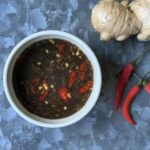


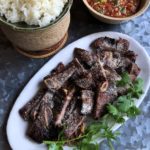


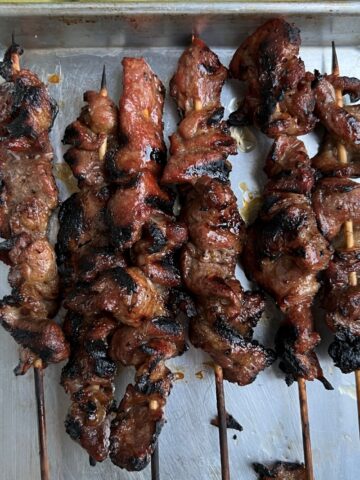
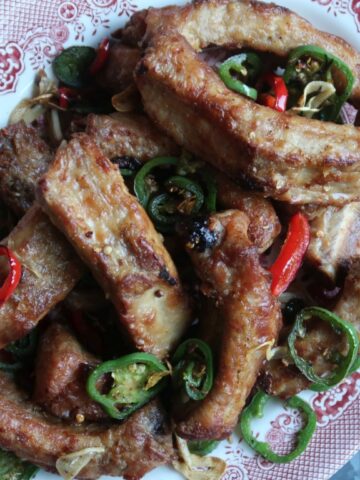
Matt Middleton says
Sounds delicious, especially the sauce! I'm curious, how long do you think it'd be ok in the fridge? I'm tempted to make a batch just for general consumption.
Andrea Nguyen says
I bet the sauce's shelf life is a good week. It's cooked! But I ate up my batch in about 4 days. Go for it!